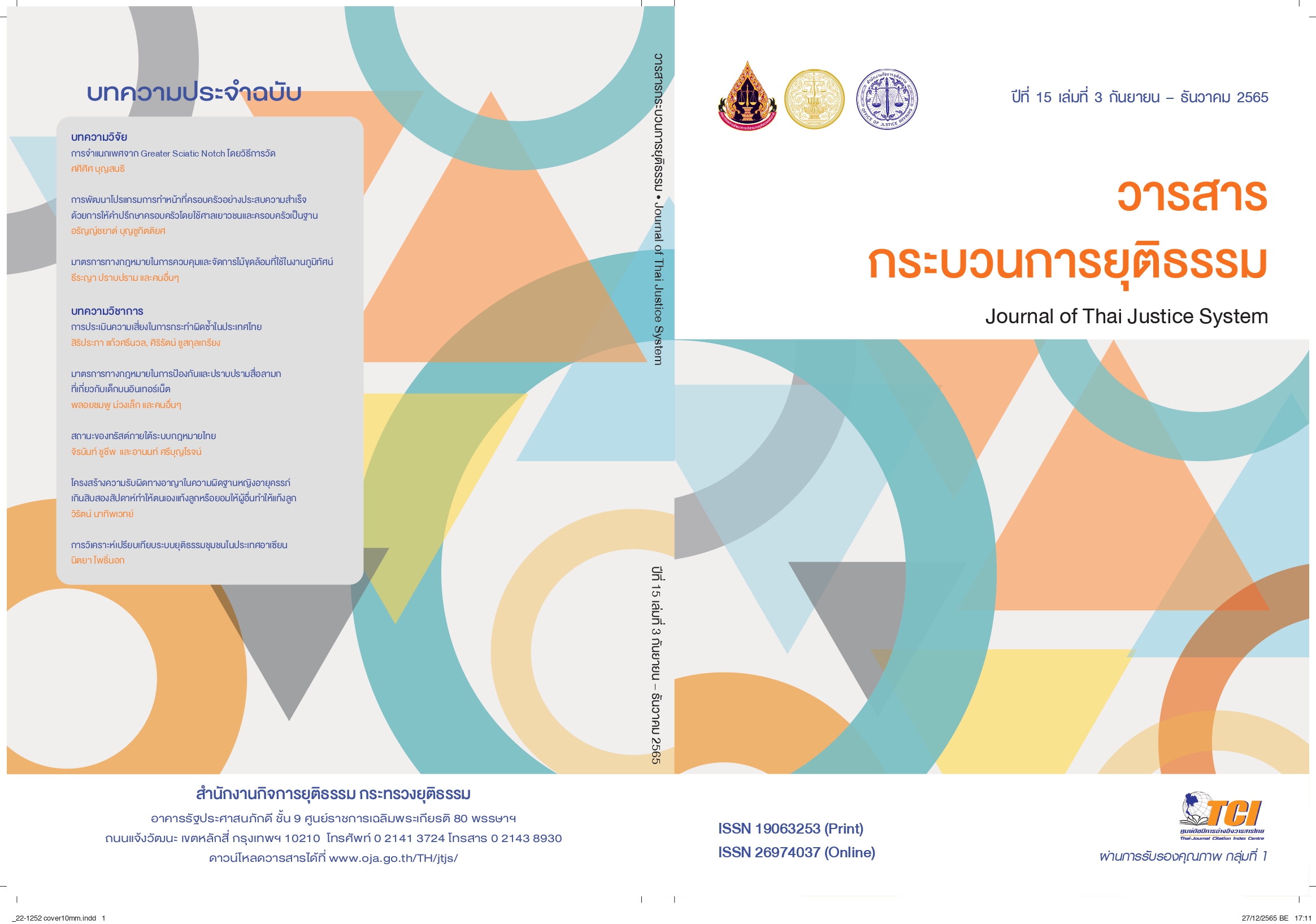A Comparative Analysis of Community Justice in ASEAN countries
Main Article Content
Abstract
Community justice is an alternative concept for governments to support improvement in the mainstream justice process. In principle, community justice is composed of four functions, namely, protection, restoration, rehabilitation, and reintegration, although most countries in ASEAN rely mainly on the restorative function. In this article, implementation of the four functions of community justice in ASEAN member countries was reviewed. In terms of the protection function, most countries focus on training in law or establishing protective groups in communities. The restorative function is evidently implemented in many countries including Thailand, Lao PDR, Philippines, and Indonesia, where community justice committees have been established in some communities to solve minor problems.For the rehabilitation function, some countries have established consultative centers as well as applied alternative methods instead of punishment. For the last function, reintegration, most countries emphasize reintegration by having youth do community social work. Therefore, Thailand could enhance the level of community justice by setting more challenging goals, tracking progress and evaluating results. In addition, perception and understanding of community justice in regard to its four functions should be broadly encouraged.
Article Details

This work is licensed under a Creative Commons Attribution-NonCommercial-NoDerivatives 4.0 International License.
Published Manuscripts are the copyright of the Journal of the Justice System. However; the opinions that appeared in the content are the sole responsibility of the author.
References
กรมคุมประพฤติ. (2549). รายงานประเมินผลโครงการพลังเครือข่ายยุติธรรมชุมชนแก้ปัญหายาเสพติด. กรุงเทพฯ: พิมพ์ดีการพิมพ์.
กิตติพงษ์ กิตยารักษ์. (2550). การพัฒนาระบบยุติธรรมชุมชนในไทย ใน กิตติพงษ์ กิตยารักษ์ (บรรณาธิการ), ยุติธรรมชุมชน : บทบาทการอำนวยความยุติธรรมโดยชุมชนเพื่อชุมชน (หน้า 15-52). กรุงเทพฯ: สำนักงานกองทุนสนับสนุนงานวิจัย.
จักกริน วรนาม, กฤชวรรธน์ โลห์วัชรินทร์ และกชพร มุสิกบุญเลิศ. (2562). เงื่อนไขที่เอื้อต่อความสำเร็จในการดำเนินงานของศูนย์ยุติธรรมชุมชนตำบลในจังหวัดขอนแก่น. วารสารสังคมสงเคราะห์ศาสตร์, 27(2), 163-193.
จุฑารัตน์ เอื้ออำนวย. (2550). ยุติธรรมชุมชน: ทฤษฎีกระบวนการยุติธรรมภาคประชาชน. ใน กิตติพงษ์ กิตยารักษ์ (บรรณาธิการ), ยุติธรรมชุมชน : บทบาทการอำนวยความยุติธรรมโดยชุมชนเพื่อชุมชน (หน้า 53-70). กรุงเทพฯ: สำนักงานกองทุนสนับสนุนงานวิจัย.
จุฑารัตน์ เอื้ออำนวย. (2556). ระบบยุติธรรมและยุติธรรมทางเลือกแนวการวิเคราะห์เชิงสังคมศาสตร์. กรุงเทพฯ: สำนักพิมพ์แห่งจุฬาลงกรณ์มหาวิทยาลัย.
เดชา สังขวรรณ. (2550). สถานภาพและแนวทางการพัฒนางานยุติธรรมชุมชนในสังคมไทย ใน กิตติพงษ์ กิตยารักษ์ (บรรณาธิการ), ยุติธรรมชุมชน : บทบาทการอำนวยความยุติธรรมโดยชุมชนเพื่อชุมชน (หน้า 165-200). กรุงเทพฯ: สำนักงานกองทุนสนับสนุนงานวิจัย.
นิตยา โพธิ์นอก และณัฏฐกาญจน์ ศุกลรัตนเมธี. (2560). รายงานวิจัยฉบับสมบูรณ์โครงการศึกษาระบบยุติธรรมชุมชนในประเทศประชาคมอาเซียน: กรณีศึกษาสาธารณรัฐประชาธิปไตยประชาชนลาว. ค้นเมื่อ 30 กันยายน 2562, จาก https://www.kpi.ac.th/knowledge/research/data/129
เนาวรัตน์ พลายน้อย. (2550). ข้อเสนอต่อการดำเนินโครงการพัฒนาระบบงานยุติธรรมชุมชนระดับจังหวัด ใน กิตติพงษ์ กิตยารักษ์ (บรรณาธิการ), ยุติธรรมชุมชน : บทบาทการอำนวยความยุติธรรมโดยชุมชนเพื่อชุมชน (หน้า 287-314). กรุงเทพฯ: สำนักงานกองทุนสนับสนุนงานวิจัย.
ถวิลวดี บุรีกุล, นิตยา โพธิ์นอก และวลัยพร ล้ออัศจรรย์. (2562). ระบบยุติธรรมชุมชนในประเทศประชาคมอาเซียน: กรณีศึกษาสาธารณรัฐฟิลิปปินส์. กรุงเทพฯ: สถาบันพระปกเกล้า.
วันชัย รุจนวงศ์. (2550). ยุติธรรมชุมชน: การสร้างความยุติธรรมโดยชุมชน ใน ยุติธรรมชุมชน : บทบาทการอำนวยความยุติธรรมโดยชุมชนเพื่อชุมชน. กรุงเทพฯ: สำนักงานกองทุนสนับสนุนงานวิจัย.
วันชัย วัฒนศัพท์. (2553). แนวทางการบริหารจัดการความขัดแย้งในท้องถิ่น. ค้นเมื่อ 26 มิถุนายน 2559, จาก envi-mining.dpim.go.th/news/ac1-t1307603627.doc
สำนักนโยบายและยุทธศาสตร์. (2550). การประเมินผลโครงการพัฒนาระบบงานยุติธรรมชุมชนในจังหวัดนำร่อง 17 จังหวัด. ม.ป.ท.
สำนักนโยบายและยุทธศาสตร์. (2551). การประเมินผลงานยุติธรรมชุมชน กระทรวงยุติธรรม ปีงบประมาณ พ.ศ. 2549 - 2551. กรุงเทพ: โรงพิมพ์สำนักงานพุทธศาสนาแห่งชาติ.
สุณีย์ กัลป์ยะจิตร และคนอื่น ๆ. (2554). รายงานผลการวิจัย การติดตามและประเมินผลงานยุติธรรมชุมชน. สมุทรปราการ: สินทวีกิจ พริ้นติ้ง.
สุรชัย ไวยวรรณจิตร และคนอื่น ๆ. (2559). การปฏิรูปกระบวนการยุติธรรมในพื้นที่จังหวัดชายแดนภาคใต้. ค้นเมื่อ 5 ธันวาคม 2565, จาก https://www.kpi.ac.th/knowledge/research/data/248.
อัคคกร ไชยพงษ์ และคนอื่น ๆ. (2561). แนวทางการพัฒนายุติธรรมชุมชนของตำบลหนองโก อำเภอกระนวน จังหวัดขอนแก่น. สุทธิปริทัศน์, 32(103), 203-216.
Austral, G. (2012). A guide to the Katarungang Pambarangay System. Philippines: Philippines Center for Civic Education and Democracy.
Bazemore, G., & Schiff, M. (2001). Restorative community justice: Repairing harm and transforming community. Cincinnati: Anderson Publishing.
Bulan, R. (2014). Dispute Resolution: Restorative Justice under Native Customary Justice in Malaysia. In S., Elsa (Ed.). Indigenous Peoples’ Access To Justice, Including Truth And Reconciliation Processes (pp.319-343). New York: Institute for the Study of Human Rights, Columbia University Publisher Location.
Chear, P. K. (2011). Restorative justice in the Cambodian Community: Challenges and possibilities in practice. Retrieved May 28, 2018, from
Clark, S. (2005). Informal dispute resolution in East Java. Retrieved May 28, 2018, from http://documents.worldbank.org/curated/en/491731468040154924/text/400730Informal1n0East0Java01PUBLIC1.txt
Clear, T. R. et al. (2011). Community Justice (2nd ed.). New York: Routledge.
Congress of the Philippines. (1991). An act providing for alLocal government code of 1991. Retrieved October 17, 2017, from http://www.lawphil.net/statutes/repacts/ra1991/ra_7160_1991.html
Cox, P. (2010). Juvenile justice reform and policy convergence in the New Vietnam. Youth Justice, 10(3), 227-244.
Ministry of Law, Singapore. (1999). Community justice guide. n.p.
Mundia, L. et al. (2016). Addressing crime problems in Brunei Darussalam: Qualitative analysis of alternatives to counseling and educational interventions. The Social Sciences, 11(2), 53-59.
Nicholson, P. (2010).Access to justice in Vietnam. In J. Gillespie & A. H. Y. Chen (Eds.) Legal reforms in China and Vietnam : A comparison of Asian Communist Regimes (pp.188-215). London: Routledge.
Parole and Probation Administration, Department of Justice, Republic of Philippines (PPA). (2014). Restorative justice. Retrieved November 6, 2017, from http://probation.gov.ph/restorative-justice/
Presidential Decree. (1978). Establishing a system of amicably settling disputes at the Barangay Level. Retrieved October 17, 2017, from http://www.lawphil.net/statutes/presdecs/pd1978/pd_1508_1978.html
Scheye, E., & Serei, S. O. (2016). Cambodia Community Justice Assistance Partnership (CCJAP) Independent Evaluation. Retrieved June 2, 2022, from https://www.dfat.gov.au/sites/default/files/cambodia-community-justice-assistance-partnership-ind-evaluation-july-2016.pdf
Scott, M. S. (2006). Community justice in policing. Idaho Law Review, 34, 1-27.
State Courts of Singapore. (2015). Media release: Launch of the community justice and Tribunals Division. Retrieved May 28, 2018, from https://www.statecourts.gov.sg/NewsAndEvents/Documents/Media%20Release%20for%20launch%20of%20CJTD.pdf
Thailand Institute of Justice. (2015). The seminar on promoting community-based treatment in the ASEAN region. Bangkok: Author.
The Border Consortium (TBC.). (2014). Protection and security concerns in South East Burma /Myanmar. Bangkok: Wanida Press.
Tongyai, R. (2019). Thai community justice: From ideas to actions. International Journal of Crime, Law and Social Issues, 6(1), 39-46.
Vanna, D., & Fargher, J. (2014). Cambodia community justice assistance partnership: Six-Monthly progress report. Australia: Department of Foreign Affairs and Trade.
Woodhouse, A. (2004). Village justice in Indonesia: Working paper No. 31616. Retrieved May 28, 2018, from http://documents.worldbank.org/curated/en/560911468756330215/Village-Justice-in-Indonesia


